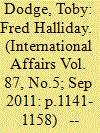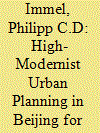| Srl | Item |
| 1 |
ID:
107562


|
|
|
|
|
| Publication |
2011.
|
| Summary/Abstract |
This article examines Fred Halliday's research and writing on the politics of the Middle East. It classifies Halliday as a 'high modernist', who organized his work around a constant commitment to a universal rationality, historical progress and an opposition to relativism and a particularist reading of the Middle East. The article identifies the two dominant units of analysis that shaped Halliday's work on the region throughout his life. These were the transformative capacity of capitalism and the role of a comparatively autonomous state. The article then examines how the content of each unit was transformed as Halliday moved from an overt Marxism to a more diffuse liberalism. It then goes on to argue that Halliday's ideological affinities and his deployment of these units marginalized the role and importance of ideology, specifically both nationalism and Islamism. Finally, it traces the influence of this approach and the deployment of these units in Halliday's work on Iran, Iraq and the Arab-Israeli conflict.
|
|
|
|
|
|
|
|
|
|
|
|
|
|
|
|
| 2 |
ID:
178306


|
|
|
|
|
| Summary/Abstract |
This article analyses the implementation process of Beijing’s current urban master plan using the background of modernisation theory. The line of thought behind the new urban master plan follows a high-modernist ideology embedded in an environment of reflexive modernity. Intermediate goals of the urban master plan are to tighten population control and increase social legibility of the city, providing an additional explanation for state-led urbanisation besides economic reasons. Urban planning is thus used as a social control mechanism and has emerged as a new means to maintain social distinction, creating new forms of exclusion. It can be observed that disruptive Mao era style pushes are still being employed in the policy cycle even today. This becomes evident from the implementation style of urban planning, where campaign-style and regularised implementation methods are complementing each other. This is corroborated through documentary analysis, interviews, and fieldwork conducted by the author.
|
|
|
|
|
|
|
|
|
|
|
|
|
|
|
|